Big Machine Reveals Small Worlds
A football-field-sized machine is giving researchers insight into medicine, forensics, and even chocolate.
Share this:
- Share via email (Opens in new window) Email
- Click to share on Facebook (Opens in new window) Facebook
- Click to share on X (Opens in new window) X
- Click to share on Pinterest (Opens in new window) Pinterest
- Click to share on Reddit (Opens in new window) Reddit
- Share to Google Classroom (Opens in new window) Google Classroom
- Click to print (Opens in new window) Print
By Emily Sohn
Inside a shiny new machine in suburban Melbourne, Australia, tiny particles are whizzing around at nearly the speed of light.
The football-field–size machine, called a synchrotron, uses tubes, magnets, vacuum pumps, and other gadgetry to produce intensely powerful beams of light. The giant contraption looks like something out of a science fiction movie.
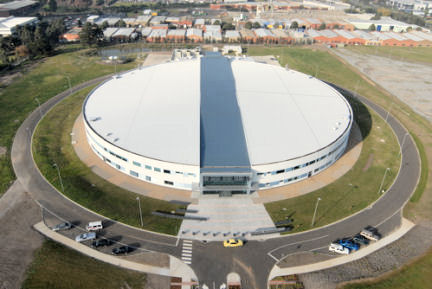 |
|
From above, the Australian synchrotron doesn’t look like much. Inside the football-field–size machine, tiny but powerful experiments are going on.
|
| Australian Synchrotron Project |
But it’s no fantasy. Real scientists are using these huge machines to look deeper than ever into the structure of atoms and cells. The work is giving them insights into our bodies and our world.
“Every kid knows about microscopes that let you see what the eye can’t see,” says Daniel Häusermann, an imaging and medical therapy scientist. He works with the Australian synchrotron, which began conducting experiments in April 2007.
“This is [like] the next level of microscope,” Häusermann says. “We always want to see … the unknown. This is what is fascinating.”
Fast particles
The Australian synchrotron is a type of machine called a particle accelerator. To understand how it works, you have to know some things about matter—the “stuff” that makes up everything in the universe.
All matter is made up of tiny particles called atoms. There are more than 100 types of atoms, including hydrogen, oxygen, and nitrogen. Just like the 26 letters of our alphabet combine to make up all the words in our language, atoms combine into molecules to make up everything we know. One atom of oxygen and two atoms of hydrogen, for example, form a molecule of water.
But atoms themselves are made up of even smaller particles. There are three types of such particles: protons, neutrons, and electrons.
And it is electrons that make synchrotrons tick. These particles have electric charges. When electrons move, they create electric currents.
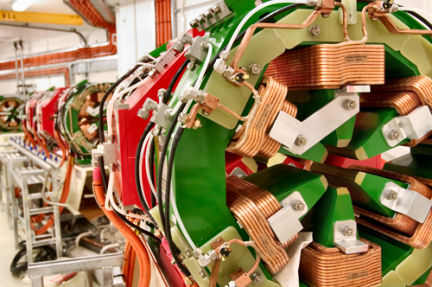 |
|
Inside a synchrotron, big magnets, like the six shown above, help get electrons moving at nearly the speed of light.
|
| Australian Synchrotron Project |
A synchrotron uses giant magnets, radio waves, and something called an electron gun to push electrons until they move at a blistering 99.9987 percent of the speed of light. That’s almost 300,000 kilometers (186,000 miles) per second. Nothing we know of moves faster than light.
Once the electrons get moving in the synchrotron, they travel through a large, ring-shaped tube that measures 216 meters (709 feet) around. The electrons make 1.34 million laps around the ring in a single second. Moving at that rate, they could zoom around the world seven times in the same amount of time.
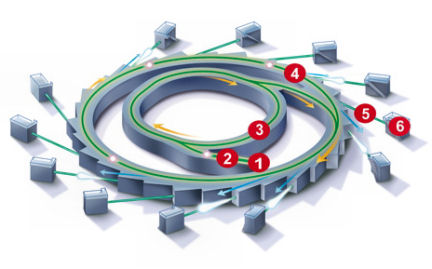 |
|
Follow the numbers to track the movement of electrons through a synchrotron. The electrons pick up speed as they zoom through the inner ring. Numbers 5 and 6 show where a powerful beam of light emerges at perpendicular angle from the central ring.
|
| Australian Synchrotron Project |
Electrons moving that quickly produce extremely bright light. Inside the synchrotron, magnets direct this light into beams, called beamlines, which come out of the machine in straight lines perpendicular to the central ring (see illustration above).
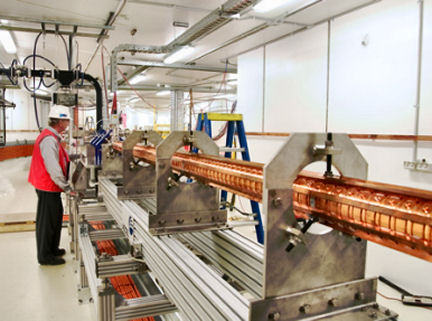 |
|
A technician examines the inner workings of the Australian synchrotron.
|
| Australian Synchrotron Project |
A synchrotron’s beamlines are between 30,000 and 30 million times as bright as the light that comes out of a laser pointer. Because synchrotrons create such strong, focused light, these machines can be used for a huge range of applications, from designing life-saving therapies to creating tastier chocolate.
“In the world of synchrotrons, you meet people who do everything,” Häusermann says, including chemists, doctors, and food researchers. “It’s more interesting than any world I’ve seen.”
Working with light
Light comes in a range of energies, called wavelengths. Some wavelengths of light we can see. Of those, we see different wavelengths in different colors. The color red, for example, has lower energy than the color violet. Other wavelengths, including high-energy X rays and low-energy infrared light, are invisible to human eyes.
Each beamline in a synchrotron is designed to emit just one type of light with a very specific amount of energy. The Australian synchrotron can produce light at wavelengths ranging from infrared to X rays. Each type of light can be used for very different purposes.
Scientists already use different types of light to do different things. Night-vision goggles, for example, use infrared light to reveal pockets of heat, allowing the wearer to “see” in the dark. And X-ray machines allow doctors to see through a patient’s skin and muscle all the way to the bone.
Because synchrotron beamlines are so powerful, they can be used for even more high-tech applications. Infrared beamlines, for example, can be used to study fragile archaeological remains and to examine processes inside living cells. Häusermann, for one, plans to work with a beamline that will produce superpowerful X rays for medical applications.
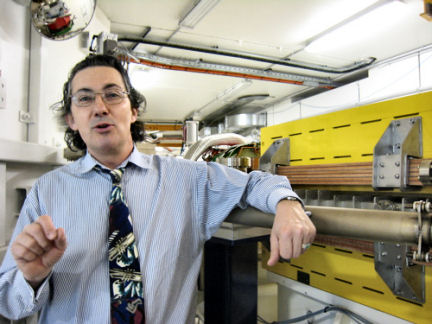 |
|
Researcher Daniel Häusermann plans to use the Australian synchrotron to see inside the human body in greater detail than ever before.
|
| Emily Sohn |
Now under construction, this X-ray beamline intended for medical purposes will travel 150 meters (492 feet) in a straight line away from the central ring through a tunnel into another building.
At the point where the beam emerges from the machine, it will measure just 1 cm (0.4 inch) across. The beam will get wider as it travels. By the time it gets to its destination, it will be 60 cm (24 inches) wide.
“We will have the widest [synchrotron X-ray] beam in the world,” Häusermann says.
He and colleagues plan on using the beamline to help cancer patients. The beam’s great width will allow the researchers to easily examine an entire body part, such as the chest. Though conventional X rays already allow researchers to see inside the body, the synchrotron’s powerful X-ray beams will allow doctors to see inside a single cell.
Better images will give all doctors a clearer window into the workings of the human body, Häusermann says, even those who don’t have the time or money to use synchrotron technology.
“The whole medical community learns from what is being done in the synchrotron,” he says.
The synchrotron can be used to treat diseases, as well as to diagnose them. For example, doctors also often use X rays to kill cancer cells. Radiation treatments are imprecise, however, and many healthy cells die in the process. That makes cancer patients feel sick. By using the highly focused synchrotron X-ray beam, scientists hope to destroy individual cancer cells without harming healthy tissues.
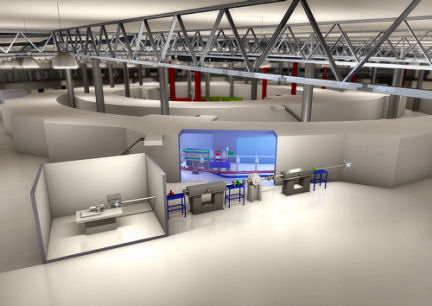 |
|
This illustration shows a high-powered beamline emerging from the synchrotron into an experimental booth.
|
| Australian Synchrotron Project |
So far, five beamlines are working at the Australian synchrotron. Four more are under development. Eventually, there may be as many as 30.
Solving mysteries
Medicine isn’t the only field benefiting from synchrotron technology. In 1998, a chocolate company in the United Kingdom used the UK synchrotron to study individual molecules during the production of chocolate.
The synchrotron’s X-ray beam revealed that the company was keeping the temperature too high for too long while processing the chocolate, says Stefanie Pearce, communications manager at the Australian synchrotron. The company changed its production methods. The result? A smoother, better-tasting chocolate.
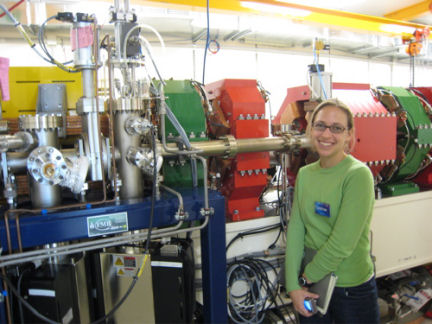 |
|
SNK reporter Emily Sohn marvels at the complexity of the Australian synchrotron.
|
|
Hannah Hoag
|
By revealing molecule-size details such as these, synchrotrons have also helped scientists create more-absorbent baby diapers, better packaging for potato chips, and higher-performing jet engines.
Synchrotron techniques are also helpful in solving crimes. That’s because they can identify specks of sweat, poison, and counterfeit ink that are undetectable by conventional forensic techniques.
Researchers can even use synchrotrons to solve historical mysteries. Consider, for example, the mysterious death of Phar Lap, one of the greatest racehorses that ever lived.
In 1932, at the height of his career, Phar Lap was suddenly stricken with a high fever and severe pain. He died soon after, and an examination showed an inflamed stomach. Immediately, people began wondering whether the horse had been poisoned.
Firm proof did not come until 2006, when Australian researchers used a synchrotron’s X-ray beam to analyze a sample of Phar Lap’s hair. The test revealed traces of arsenic. The scientists concluded that it was almost certain the horse had been poisoned with a large dose of this toxic chemical.
The list of synchrotron applications goes on and on. And the work, Häusermann says, is endlessly fascinating.
“We’re just big kids,” he says, “Playing with expensive toys.”
Going Deeper:







